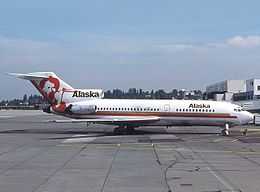Alaska Airlines Flight 1866
|
Alaska AL Boeing 727-100 similar to the accident aircraft | |
| Accident summary | |
|---|---|
| Date | September 4, 1971 |
| Summary | Controlled flight into terrain |
| Site | Haines Borough, Alaska |
| Passengers | 104 |
| Crew | 7 |
| Fatalities | 111 (all) |
| Survivors | 0 (none) |
| Aircraft type | Boeing 727-100 |
| Operator | Alaska Airlines |
| Registration | N2969G |
| Flight origin | Anchorage |
| 1st stopover | Cordova, Alaska |
| 2nd stopover | Yakutat, Alaska |
| 3rd stopover | Juneau, Alaska |
| 4th stopover | Sitka, Alaska |
| Destination | Seattle-Tacoma International Airport |
Alaska Airlines Flight 1866 was a regularly scheduled flight from Anchorage, Alaska to Seattle Washington, with intermediate stops. On September 4, 1971, the aircraft serving the flight crashed into a mountain in Haines Borough, near Juneau, Alaska (JNU/PAJN) on approach for landing. 111 people were killed.[1] It was the first fatal jet airliner crash of Alaska Airlines, and the worst single plane crash in the history of the United States until June 24, 1975, when Eastern Airlines Flight 66 crashed.
Preflight history
The aircraft was a Boeing 727-100 with U.S. registry N2969G[2] manufactured in 1966 as c/n 19304 and manufacturer’s serial number 287. It had accumulated 11,344 flight hours prior to the incident. Flight 1866 originated in Anchorage, Alaska and had stopped at Cordova (CDV) and Yakutat (YAK/PAYA). It was scheduled to stop in Juneau and Sitka before ending in Seattle. The flight landed at Yakutat at 11:07 a.m and departed on the accident flight at 11:35 a.m. for Juneau.
The captain of the flight was Richard C. Adams, age 41 at the time of the crash. Piloting the aircraft at the time was First Officer Leonard D. Beach, age 32. James J. Carson was the second officer. Beach and Carson had been employed with Alaska Airlines in 1966. Adams had been with Alaska Airlines since 1955.
Seven crew members were aboard, as well as 104 passengers.
Accident flight
The aircraft struck the eastern slope of a canyon in the Chilkat Range of the Tongass National Forest at the 2500-foot level, 35 km (22 mi) west of Juneau. The aircraft disintegrated on impact at 12:15 p.m. There were no survivors.
Investigation
The NTSB released their report on 11 October 1972. In it, they stated that the probable cause of the accident was "a display of misleading navigational information concerning the flight's progress along the localizer course which resulted in a premature descent below obstacle clearance altitude. The origin or nature of the misleading navigational information could not be determined. The Board further concludes that the crew did not use all available navigational aids to check the flight's progress along the localizer nor were these aids required to be used. The crew also did not perform the required audio identification of the pertinent navigational facilities."[3]
Aviation writer Robert J. Serling's 2008 history of Alaska Airlines, Character and Characters, includes a description of the NTSB investigation and subsequent independent investigations.[4]
Modern improvements relating to Juneau
In 1989, Alaska Airlines became the first airline to use head-up guidance systems for passenger flights. These are credited for reducing disruptions caused by fog.[5] Alaska Airlines is credited as being an airline pioneer in the use of head-up displays, which are seen as assisting air crews to fly to challenging airports.[6] Juneau has been reported to be a challenging airport.[7] Takeoffs sometimes require a 180-degree turn inside between an island and the mainland, both of which have steep terrain. In addition, there can be high winds in the vicinity.[8]
References
- ↑ HistoryLink Essay: Alaska Airlines - A Snapshot History
- ↑ DCA72AZ003
- ↑ Accident description at the Aviation Safety Network
- ↑ 40 Years ago, 111 died in Alaska Airlines Crash Near Juneau
- ↑ Alaska Airlines Company Facts Technology
- ↑ HUDs and enhanced vision: more efficiency, reduced costs.(Head Up Display technology) | Interavia Business & Technology | Find Articles at BNET.com
- ↑ Coordination Meeting #1, Delay Reduction Strategy
- ↑ Aviation and Turbulence: FAA and NCAR Continue Investigations
External links
- National Transportation Safety Board report (Archive)
- 1972 photograph of another Alaska Airlines 727-100 series aircraft
| ||||||||||
| ||||||||||||||||||||||||||||||||||
Coordinates: 58°21′42″N 135°10′12″W / 58.361666°N 135.170000°W
